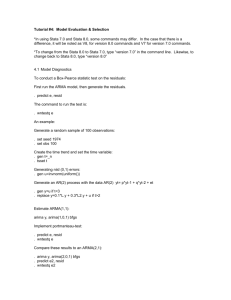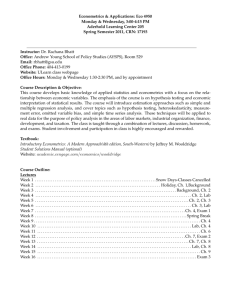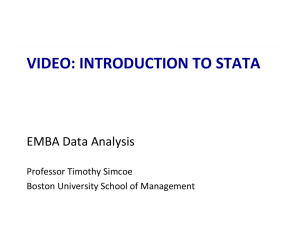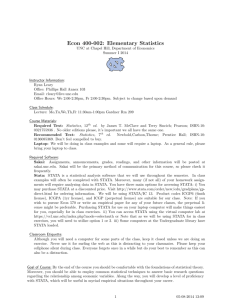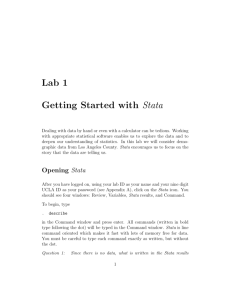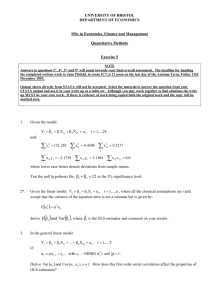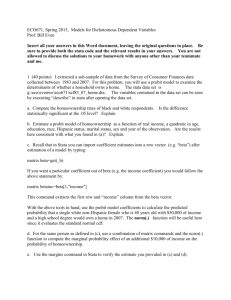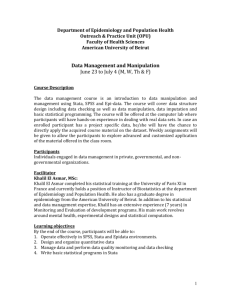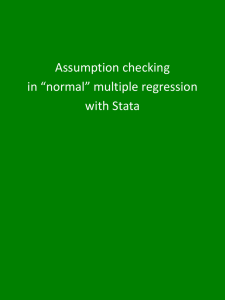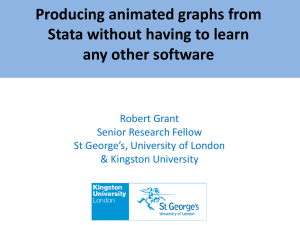se13_grund
advertisement
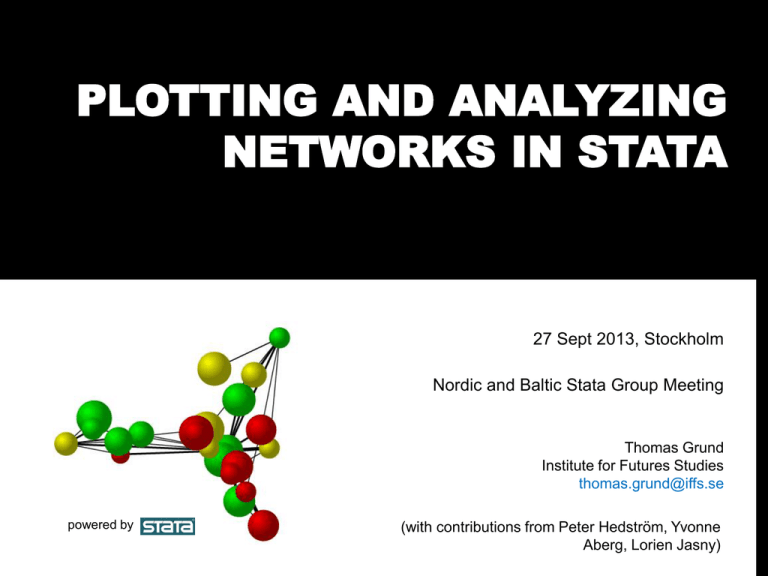
PLOTTING AND ANALYZING
NETWORKS IN STATA
27 Sept 2013, Stockholm
Nordic and Baltic Stata Group Meeting
Thomas Grund
Institute for Futures Studies
thomas.grund@iffs.se
powered by
(with contributions from Peter Hedström, Yvonne
Aberg, Lorien Jasny)
WHY NETWORK ANALYSIS
WITH STATA?
Given the availability of specialized software programs for social
network analyses such as Ucinet, Pajek or packages in R, why do
we believe that Stata is a useful environment for such analyses?
1. Introduction of Mata makes network analysis easier and
feasible. Much richer set of tools for describing and analyzing
the results of the analyses than most dedicated programs for
social network analysis (except R).
2. Reduces learning and re-tooling costs. Transition will be
smoother for those who already use Stata. Many social
scientists know Stata.
3. Nice graph engine available.
SOCIAL NETWORKS
𝑁 = 𝐺 𝑉, 𝐸
𝑉 = 𝑣1 , 𝑣2 , 𝑣3 , 𝑣4 … 𝑣𝑁
𝐸=
𝑣1 , 𝑣2 , … 𝑣𝑁
directed/undirected tie
weighted/unweighted tie
simple/multiple ties
symmetric network
multiplex network
one-mode/two-mode network
see e.g. Wasserman & Faust (2001)
ADJACENCY MATRIX
A convenient representation of graphs and digraphs (we often just
say “graphs" when we also refer to digraphs) is the adjacency matrix:
j is adjacent to i if there is a tie from i to j;
the adjacency matrix is the matrix (yij ) with
1
y ij
0
, if there is a tie from i to j
, if there is no tie from i to j
The diagonal of the adjacency matrix will be structurally zero
when there are no self-ties.
STORING NETWORKS
2
8
1
3
7
4
5
9
6
Individual:
Relation:
Note:
Directed vs. undirected paths.
Weighted vs. unweighted paths.
Network change as changes in the
cells of the adjacency matrix.
0
0
0
1
0
0
0
0
0
1
0
0
1
0
0
0
0
0
1
0
0
0
0
1
0
0
0
0
0
1
0
0
0
0
0
0
0
0
0
1
0
0
0
0
0
1
0
1
0
1
0
0
0
0
0
1
0
1
0
0
0
0
0
0
0
0
0
0
0
0
0
0
0
0
0
0
0
0
0
0
0
nw-package
NWCOMMANDS
nwimport: import either Ucinet, Pajek, matrix
nwrandom: create Erdos-Renyi network
nwlattice: create regular lattice
nwsmall: create small-world network
nwpref: create preferential attachment network
nwcommun: create community network
RANDOM NETWORK
MDS Layout
1
3
9
6
8
10
6
5
8
10
7
1
2
5
2
7
4
4
9
nwrandom 10, prob(0.8)
nwgraph
3
nwrandom 10, prob(0.3)
nwgraph
LATTICE NETWORK
Lattice Layout
MDS Layout
9
3
4
5
6
7
8
9
10
11
12
13
14
15
16
17
18
19
20
21
22
23
24
25
3
8
5
2
20
7
1
13
25
19
2
4
10
15
14
1
6
24
12
11
21
18
23
16
22
17
nwlattice, rows(5) cols(5)
nwgraph
nwlattice, rows(5) cols(5)
nwgraph, lattice
SMALL WORLD NETWORK
Circle Layout
4
3
5
2
6
1
7
15
8
14
9
13
10
11
12
nwsmall, neighb(4) shortc(5)
nwgraph, circle
6
5
15
PREFERENTIAL
ATTACHMENT NETWORK
4
7
3
2
9
1
20
5
10
Frequency
10
8
11
19
18
13
17
14
15
16
nwpref 20, minout(2) maxout(2)
nwgraph, cricle
0
12
0
5
10
indegree
15
20
nwdegree
hist indegree, width(1) freq
COMMUNITY NETWORK
3
1
4
5
19
9
2
8
6
15
7
14 20
13
18
11
17
10
12
16
22
23
24
21
30
28
27
25
26
29
nwcommun 30, groups(3) gprob(0.4) prob(0.05)
nwgraph, cat(groupid)
NWSVGGRAPH
powered by
NWSVGGRAPH
powered by
NETWORK DYNAMICS
powered by
SVG – SCALABLE VECTOR
GRAPHICS (W3C)
nwsvggraph
PROCESS VECTOR
GRAPHICS
shell network.svg
NWSVGGRAPH
Many options…
-
General: width(600) height(300) ystretch(.8) xstretch(.5)
-
Layout: mds, circle, lattice
-
Background: background1(255 0 255)
-
Label: labeltext(“my network”) labelsize(15)
-
Label: labelx(10) labely(20) labelcolor(yellow)
-
Nodes:
-
- nlabels(id)
- nfactor(3) ncolor(mycolors) nsize(mysizes)
Edges:
- arrowhead
- efactor(2)
…
NWSVGGRAPH
ANIMATION
nwsvggraph, nsize(size_time*)
NWSVGGRAPH
ANIMATION
nwsvggraph, nsize(size_time*) ncolor(col_time*)
NETWORK
PROPERTIES
Number of neighbours (degree)
How many ties do individuals have?
What is the average number of individuals that any individual in the
network interacts with?
Clustering
Of the individuals that I interact with, what fraction of those also
interact with each
The friends of my friends are my friends
Shortest paths
How many interactions does it take to get from one person in the
network to any other person in the network?
What is the longest amount of time it takes to get from any one
person in the network to any other person other?
NWCOMMANDS
nwimport: imports network data
nwgraph: simple graph
nwsym: make network symmetric
nwtoedge, nwtoadj, nwfilledge: transform format
nwtomata, nwtostata: communicate with Mata
nwneighbor: get selection of network neighbors
nwcontext: retrieve attribute information from neighbors
nwdensity: density of the network
nwdegree: degree of nodes
nwcluster: local and global clustering
nwcloseness: local and global closeness
nwcomponents: connected components
nwgeodesic: shortest paths between nodes
….
A lot of these commands draw on our nwcommands.mlib library
Not available through Stata findit yet.
SIMPLE AGENT-BASED MODEL
nwlattice, r(10) c(10)
nwsym, unweighted
nwdegree
gen threshold=uniform() * outdegree
gen act = int(uniform()+.1)
forvalues t=1/50 {
gen act_time`t' = act
nwcontext act, gen(pressure)
replace act = 1 if pressure >= threshold & act == 0
drop pressure
}
OUTLOOK ?
• Basically, keep programming Ucinet functions in Stata…
• Add functionality to nwsvggraph…
• Add capabilities for network modeling:
• p1, p2 models…
• Permutation tests…
• Piggyback on existing libraries in R (ergm, RSiena)…
• Make it all available as nw-package
